
by David McGuffin | Aug 4, 2014 | Blog, David's Journal, Experiencing Europe
Enjoying the opportunity to sleep in!
We slept in this morning, knowing there would be plenty of time to explore Athens in the next few days. After breakfast, Charlotte and I checked out of the Electra Hotel and walked five blocks to their sister hotel, The Electra Palace. Normally, I do not change accommodations, but we are booking this trip as we go, not knowing from day-to-day what the next one holds.
The Electra Palace
 The Electra Palace has one benefit over the Electra Hotel and that is its rooftop pool with grand views of the Acropolis. We are paying premium prices for our room here, but the benefit of having an “oasis” in the heart of Athens, plus the rooftop pool makes it a worthwhile expense.
The Electra Palace has one benefit over the Electra Hotel and that is its rooftop pool with grand views of the Acropolis. We are paying premium prices for our room here, but the benefit of having an “oasis” in the heart of Athens, plus the rooftop pool makes it a worthwhile expense.
Our tour “group” grows…
Our friend, Janey, arrived in Athens earlier this morning and was waiting for us in the hotel lobby. As expected, our rooms were not ready, so we gave the hotel a “once over” and headed up to the rooftop pool and bar area. We took a seat, with the Acropolis hovering over us in the distance, and sketched out a rough plan for our adventure in Greece.
I had been to Athens on three previous occasions, the first in 1977 (which I will continue to reference here in my writings), the second in the summer of 2006, and the last in December 2010. But beyond Athens (and the island day trips to Aegina, Porous, and Hydra), it is all going to be a new adventure. Our rough planned itinerary looks likes this: Athens, Delphi, Olympia, the Mani Peninsula, Napflio, and the island of Santorini.
A lazy afternoon at the pool…
Later, we checked into our rooms and while Janey napped off her jetlag, Charlotte and I changed into our bathing suits and headed to the pool. We enjoyed a relaxed lunch, cool dips in the pool, and great views of the Acropolis. We were so close I could see weary and over-heated tourist walking on the Acropolis, frantically trying to fit their sightseeing in during the hottest part of the day.
Me and my journal…
I became faithful with my journal entries in the summer of 1997. Since then, I’ve kept a pretty good record of things happening in my life and especially my travels. Over the years, my journal has become a companion and a place to escape, especially when traveling alone with no one to talk to. I enjoy putting my thoughts to paper and sketching. This afternoon, I tried to capture the mood and feel of the Acropolis with this sketch.
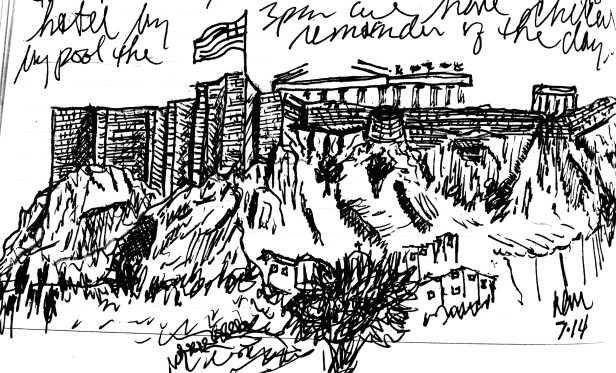
Sightseeing in the Plàka
Along about 5:30 p.m., we headed out for our sightseeing in the Plàka neighborhood. It was still hot and we stuck to the shady sides of the streets as we wound through the shopping streets, narrow lanes, past Byzantine-era churches, and the tourist oriented shops.
Ermou Street
Ermou is the main street leading from Sytagma Square into the Plàka. It once was filled with filth, loud traffic, and ugly signs. Since 2000, it has become a pedestrian-only area and both tourists and locals enjoys a stroll in this shopping oriented street.

Ermou Street
The Church of Kapnikarea
Athens was once a part of the vast Byzantine Empire which controlled much of Europe from A.D. 323-1453. This church, the Church of Kapnikarea, is a classic example of an 11th century Byzantine house of worship. Notice the classic Byzantine architectural designs including a red-tiled domed cupola topped with a cross and narrow and tall arched windows often with diamond-shaped trim.
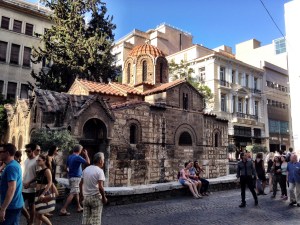
The Church of Kapnikarea
Athen’s Cathedral
This church was built in 1842 and looks much worst for wear than other churches in the area dating from 600 years before! However, it is Athen’s most important Greek Orthodox church and the “head” church of the Greek Orthodox faith. It is in dismal condition! The interior and exterior are covered with scaffolding and shrouded in construction cloth. The placard outside does list a schedule of worship services… but ughh… I can’t imaging it here.

Athens Cathedral
Adrianou Street
This IS souvenir street! Adrianou Street runs from near the new Acropolis Museum, heads north, and then turns west to follow the lays of the Acropolis hill. For me, it is the “main drag” offering all the “Greek” trinkets and souvenirs. You’ll find it all… olive oils, olive wood, worry beads, jewelry, leather sandals, sponges, Pandora beads, Greek replica statues, t-shirts, and tons of stray cats!
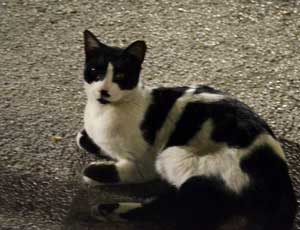
Hello kitty
The Roman Forum and Tower of the Winds
The Romans conquered Greek about 150 B.C. and set up their own “Roman”-ized way of life. The Greek Agora (I’ll address that later) became a marble “boneyard” from which the “Roman” Athens was built. Now-a-days, this area is often called the Roman Agora, but the Roman’s called it the Forum. Like in Rome, it was the commercial center of the city. A place to shop, meet, see and be seen.
Much later, the Ottomans converted this area into a bazaar. There is a mosque here in the area, although its minarets were decapitated by the Greeks when they won their independence from the Ottomans in the 1800’s.

Roman Forum & Tower of the Winds
Notice also the eight-sided domed tower known as the “Tower of the Winds.” This tower was built in the 1st century B.C. and contains a clock, a guide to the planets, and a weathervane. The carved figures depict the “winds” as winged humans who fly in and bring the weather. Don’t bother asking anyone about the meaning of the eight ancient Greek symbols for the “winds.” I’ve found everyone makes up their own story… even the guides!
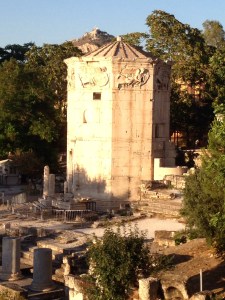
Tower of the Four Winds
Library of Hadrian
Hadrian was the Roman emperor in the 2nd century A.D. who had quite an affection for all things Greek. He had this library and civic center constructed for the Athenians. The building housed gardens, lecture halls, art galleries, and a library. Today, most of what you see is a reconstruction of one wall and a few Corinthian columns.

Library of Hadrian
Monastiraki Square
This is Athen’s second main city square loaded with old world class and style. The big building on the left is the metro station where tw0 train lines connect. From this square one could walk to the Archaeological Museum (1 mile to Omonia Square), feast on souvlaki (the typical Greek meat-on-a-stick fast food), wander into the old town, or or hop on the metro to zip off to far flung areas of town.

Monastiraki Square
By 7 p.m. we had experienced and seen the most important ancient and tourist sights in the Pàlka. Arriving at Monastriki Square and the Metro station, we decided to give the Ancient Agora a go. Following the Metro tracks, we soon came to the main Agora entrance and ticket booth.
Here’s a hint
Avoid long lines at archeological site ticket booths by arriving late in the afternoon. Alternatively, visit a lesser-known site entrance before the Acropolis. Purchase a €12 “strip ticket” for all the archeological sites in Athens including the Acropolis, Agora, Roman Forum, Keremikos Cemetery, Library of Hadrian, Theatre of Dionysus, and the Temple of Olympian Zeus. The ticket is valid for four days, and technically the attendant will tear off one “strip” for each site you visit. However, I did not have any collected except at the Acropolis. IF you purchase your ticket first at the Acropolis, then you’ll receive one ticket with a bar code that will be scanned at each site visited.

The Ancient Agora
Visiting the Ancient Agora during its final hour of the day was a good idea. Although the sun was still high and warm, there were only a few tourists milling around. We were able to see almost all the Agora sites in less than an hour, although it was a push to get up to the Temple of Hephaistos before the attendants began blowing their whistles to alert of the impending closing time of 8:00 p.m.
Temple of Hephaistos
This is one of the most well preserved of all Greek temples. Construction began here in 450 B.C. shortly after the entire Agora was destroyed by the invading Persians (480 B.C.). However, construction work stopped here while the Athenians concentrated on building the temples on the Acropolis, including the Parthenon. The temple is dedicated to Hephaistos, the “blacksmith” god and originally contained bronze statues of he and Athena.

Temple of Hephaistos
The temple was converted to a Christian church in 1300 A.D. and named the Church of St. George (the patron saint of Athens). Because of its continued use, the structure was maintained and kept up resulting in the wonderful condition in which we find it today.
The Agora in 1977
My notes, dated May 5, 1977, mention visiting the Temple of Hephaistos…
I got up at 6:15 am yesterday morning and walked down to the Temple of Zeus and took photos, then went to the Olympic Stadium and Royal Gardens. Doug and I then went and ate breakfast at the hotel. Then took an excursion to the ancient agora and the Theseion/Temple of Hephaistos and agora museum.
Here is the photo my friend Doug snapped of me standing in the temple. I recall back then we were allowed inside the temple and could actually see the ancient frieze in the alcoves depicting mythological battles between the Lapith tribe and a group of centaurs during a wedding feast.

Temple of Hephaistos 1977
Here is a photo Charlotte snapped of me in December 2010 during our visit to Athens. The temple has remained the same, I’ve not! Notice too that I was not allowed on the steps as the entire temple is fenced off.

Temple of Hephaistos 2010
Take the back gate for a speedy exit
We exited the Agora at the “back gate” up the hill in the direction of the Acropolis (Polygnotou “street” on your map). This put us up near the top (Prytaniou street) with great views of the Plàka and Athens to the north and the Acropolis looming just overhead to the south. We experienced a fantastic sunset and later, an almost full moon rising in the west.

Sunset over the Roman Forum
The Plàka is not flat.
It stretches consistently uphill until the slops of the Acropolis makes it impossible to build houses. Consequently, the “streets” are often no more than small cobbled pedestrian paths winding past shops, restaurants, and businesses. The farther uphill one wanders, the more steps and stairs are encountered.
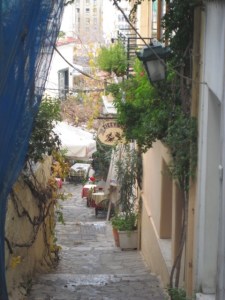
Steps and more steps
One such place, called Mnisikleous, is known for a series of cobbled stairs stretching of 100 yards and lined with trendy restaurants offering good food, decent drinks, ok music, and plenty of ambience.
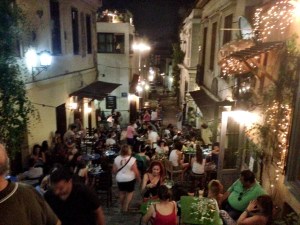
Mnisikleous Street dining
Capping off our day, we chose an outdoor restaurant known for authentic Greek food offered at very reasonable prices. Xenious Zeus is not a secret among tourist in Athens. This restaurant appears in all the guidebooks and is advertised as a place with good food and good prices. Since we were all the way up the hill, I thought we should give it a try.

.
For €12 we got a three-course meal featuring a selection of five Greek appetizers, called mezedes, a main course, and desert. We added a Greek Salad to share between the three of us. For a quick and unpretentious introduction to Greek cuisine, this place can’t be beat.

mezedes sampler
After dinner, we walked back to our hotel with a full moon rising in the west, our bellies full, and our bodies worn out. For me, this was the perfect mix of recovery, sightseeing, and dining to begin our adventures in Greece.
Read my previous post. Read my next post.

by David McGuffin | Jun 24, 2014 | Culture & Customs, Daily lfe, Destinations, Eating & Drinking, Experiencing Europe
 Why do sheep have patches of color painted on their wool?
Why do sheep have patches of color painted on their wool?
Farmers “paint” their sheep for identification. Frequently, you’ll notice large pastures blanketed in green grass and dotted with sheep. Typically, these pastures are enclosed by stone walls or wire fences and are shared by multiple farmers. When it comes time to claim ownership of the animals roaming around hundreds of acres, a customized painted sheep is easy to identify.
Also, during the mating season, the male ram will be fitted with a bag of dye around its neck and chest. When mating, the ram mounts the ewe and a bit of dye is deposited on the ewe’s upper back. This way, the farmer knows which ewes have been impregnated and moves them on to another field away from the ram.
FACT: This webpage, “Painted Sheep” gets 500-700 visits per month. It is amazing how many people are searching for this term. Do me a favor, leave a comment and let me know if I answered your question.
Thanks, David McGuffin
WHO IS DAVID MCGUFFIN?
 David McGuffin organizes, designs and leads tours to many European destinations. David’s tours are for strictly small groups ranging from 6 to 18 travelers.
David McGuffin organizes, designs and leads tours to many European destinations. David’s tours are for strictly small groups ranging from 6 to 18 travelers.
Traveling with a small group means we can get off the beaten path and away from the big bus tours and experience Europe on a unique and personal level.
Eating well is also a priority, and you’ll get your fair share of fine food sourced locally by excellent chefs. David has spent decades poking around Europe’s nooks and crannies looking for unique restaurants, clean hotels with character and cozy B&Bs.
ADDITIONAL INFORMATION ABOUT PAINTED SHEEP.
In Ireland, the top five counties in terms of sheep numbers are Donegal, Galway, Mayo, Kerry, and Wicklow. Each of these counties are located in hilly-mountainous areas of the country.
Ireland sheep flocks typically have 50 ewes or fewer. Compared to international standards, this is quite small. For example, Scotland averages 200 ewes per flock and the world largest exporter, New Zealand, average 1400.
Ireland only “keeps” 30% of it sheep for human consumption. The remaining meat is exported mostly to the UK and France.
According to a recent Irish livestock census, the island had 3.7 million sheep, 6.5 million cows, and 1.5 million pigs. With all that bacon showing up on the breakfast table this fact is going to require a little more investigation!
God intended sheep to mate in the fall and give birth in the spring when the weather would be more favorable for their survival. Therefore, sheep are known as “short day” breeders. When the days become shorter (in the autumn) this activates a hormone in the ewe’s brain that triggers the reproductive system into action.
During their fertile period ewes come into heat every 17 days or until the fertility period is complete. When in heat, the ewe flirts with the ram by wagging her tail, nudging, or cuddling.
When detecting a ewe in heat, a ram’s characteristic response is to lift his head in the air and curl his upper lip. Then, I suppose he goes for it!
A mature ram can mate with 100 or more ewes during the mating season.
The gestation period is about five months, give or take a week.
Ewes usually give birth (known as lambing) to one to three lambs.
Lambs go to “market” when they are less than one year old, and their meat is known as “lamb.” Mutton is the meat from lambs that are 1 year or older.
Wool, lanolin, and sheepskins are also products of sheep.
Finally, to leave a good taste in your mouth, about 1.3% of the world’s cheeses are products of sheep’s milk. So, the next time you try a piece of Roquefort, Feta, Ricotta, or Pecorino Romano, think about all these painted sheep!

by David McGuffin | Jun 5, 2014 | Adventures in Tour Guiding, Culture & Customs, Destinations, Eating & Drinking, Experiencing Europe
 Ireland is fast becoming my most popular tour destination. I’ve just returned home from leading a great group of people on my “Best of Ireland and Scotland” tour. Later this month, I return to the Emerald Isle for two more of my “Taste O’ Ireland” tours. Ireland (and Scotland) are a perfect destination for summer travels as the temperature rarely climbs above 68°F, the countryside is draped in 40 shades of green, and the photo ops for sheep are plentiful. We are scheduling tours for the summer of 2015, so keep an eye out for my tours to Ireland!
Ireland is fast becoming my most popular tour destination. I’ve just returned home from leading a great group of people on my “Best of Ireland and Scotland” tour. Later this month, I return to the Emerald Isle for two more of my “Taste O’ Ireland” tours. Ireland (and Scotland) are a perfect destination for summer travels as the temperature rarely climbs above 68°F, the countryside is draped in 40 shades of green, and the photo ops for sheep are plentiful. We are scheduling tours for the summer of 2015, so keep an eye out for my tours to Ireland!
Traditional folk music and singing is a nightly occurrence in Ireland. No matter what town or village, I can always find a pub with a music session. These sessions vary according to the ability and style of the musicians, but are always filled with heartfelt choruses and toe tapping jigs. It is almost as if every person on the island pops out of their mother’s womb with a song instead of a scream.
I’ve been a musician all my life, so when I hear a band in the distance or a song wafting out the door, I go for a listen. I sometimes run across situations and events that are once-in-a-lifetime opportunities where I just happen to be in the right place at the right time. In Venice, I recall sitting in on an impromptu singing session with a few salty old fishermen belting out operatic arias. On successive trips to Venice, I’ve tried to duplicate that experience and have been disappointed. Try as I might, there is no way to “manufacture” these impromptu experiences for the folks on my tours. You’ve just got to be in the right place at the right time and let it unfold around you!
![IMAG0380[2]](https://i0.wp.com/davidmcguffin.com/wp-content/uploads/2014/06/IMAG03802.jpg?resize=300%2C222&ssl=1) Knowing all this, I shouldn’t be surprised when a gem of an event unfolds around me. This time, it all started when I coaxed a few of my tour members into a deserted Irish pub. When I say deserted, I mean just that… there was not a soul in the place except for the bartender, and he looked like he was packing it up for the evening. In fact, when we asked for a pint of Kilkenny (the local ale), he had to go to the back and fiddle with the taps just to get the stuff flowing. I began making apologies to my group for bringing them in this desolate place, but the bartender had spent several minutes getting the taps to flow, so we felt obligated to stay and have a pint. There we were, just the six of us quietly sipping our pints and looking for an exit strategy.
Knowing all this, I shouldn’t be surprised when a gem of an event unfolds around me. This time, it all started when I coaxed a few of my tour members into a deserted Irish pub. When I say deserted, I mean just that… there was not a soul in the place except for the bartender, and he looked like he was packing it up for the evening. In fact, when we asked for a pint of Kilkenny (the local ale), he had to go to the back and fiddle with the taps just to get the stuff flowing. I began making apologies to my group for bringing them in this desolate place, but the bartender had spent several minutes getting the taps to flow, so we felt obligated to stay and have a pint. There we were, just the six of us quietly sipping our pints and looking for an exit strategy.
This was the third night of the tour and our first night out of Dublin. I was hoping to introduce my group to some traditional small town pub music. But it seemed tonight would not be the night. So, instead of experiencing music, I decided to at least tell my group about the “typical” pub music session to get them prepared for a future musical evening. As I was explaining the typical fiddling and singing found in a pub music session, a gentleman walked in the door. Dianne, one of my tour members, asked him, jokingly, if he was the singer for tonight’s session. He said no, he had just come in for a pint after playing two rounds of golf, but if we wait a bit we might coax one of his friends to belt out a song or two.
![IMG_0813[1]](https://i0.wp.com/davidmcguffin.com/wp-content/uploads/2014/06/IMG_08131.jpg?resize=300%2C224&ssl=1) Over the course of the next fifteen minutes, the pub filled with 20 or so Irishmen who were in Kilkenny on a golf outing. They told us this was a yearly get together to play golf, have fun, and get away from their wives (said with a joke and a laugh). So, the first gentleman says to his buddy, “this lady wants to know if you are the singer.” We all expected a laugh and a swift no, but to our surprise he stood up and belted out a heartfelt ballad about “Annie Moore”, Ireland’s first immigrant to the United States.
Over the course of the next fifteen minutes, the pub filled with 20 or so Irishmen who were in Kilkenny on a golf outing. They told us this was a yearly get together to play golf, have fun, and get away from their wives (said with a joke and a laugh). So, the first gentleman says to his buddy, “this lady wants to know if you are the singer.” We all expected a laugh and a swift no, but to our surprise he stood up and belted out a heartfelt ballad about “Annie Moore”, Ireland’s first immigrant to the United States.
Then began a chain reaction where each man stood and sang his favorite song. All was done a cappella, without accompaniment, and from the heart. They took great pride in their singing and in the message of the song. We were an audience of six Americans who were looking for some music, and boy did we get it! By the end of the night we were invited to join them in “God Bless America”, finally finishing the session at midnight belting out “cockles and mussels… alive, alive oh.”
[space height=10] You would think with six of us witnessing this impromptu singing session we would have taken some video. Unfortunately, all were having too much fun to waste time on video. So, this short segment is all I have to offer. You’ve just got to be at the right place at the right time! [space height=10] [column col=”1/2″] [youtube height=”200″ width=”290″ align=”left”]https://www.youtube.com/watch?v=pw4yqb8s9hI[/youtube][/column] [column col=”1/2″ last=”true”]

by David McGuffin | May 9, 2014 | Adventures in Tour Guiding, Blog, Destinations, Experiencing Europe
A few years ago Alain Maurel, my friend and bus owner, suggested I visit Vézelay. He told me it was a pity to miss such a charming village that was only a few miles off the busy autoroute from Burgundy to Paris. So, last year I gave Vézelay a “test run” and discovered I had indeed been missing a hidden gem. This travel season I’ve included Vézelay in my Germany, Austria, Switzerland, and France itinerary and all agree, it is a keeper!
Vézelay is in an imposing position strung out along the crest of a hill, with far-reaching views over the ‘Monts de Morvan’ and on the edge of the Morvan Regional Park.

20 minutes off the autoruote

Vézelay as viewed from the Monts de Morvan
Many of the houses along the main street are now cafes, galleries and gift shops but there is none of the “worthless junk” along the road that occupies many a tourist town – if you are look- ing for tacky souviners, you will need to look elsewhere.


The highlight of the village is without doubt the Abbey of St Mary Magdalene, an awe-inspiring building with soaring decorative vaults. The abbey contains the relics of Saint Mary and was historically the departure point for pilgrims to Santiago de Compostella.

The drive to and from Vézelay is beautiful. These photos were taken a few days ago at the start of May.



by David McGuffin | May 8, 2014 | Blog, Culture & Customs, Daily lfe, Destinations, Experiencing Europe, Holiday
I am smack dab in the middle of my Best of Germany, Austria, Switzerland, and France tour. I picked up a group of just four folks a few days ago in Munich and we’ve had a blast getting to know each other and experiencing Germany and Austria. It being the beginning of spring, we’ve run in to several celebrations dedicated to digging out of the gloomy winter and leaping into spring.

Frühlingfest Munich

Frühlingfest Munich
In Munich, the massive outdoor Octoberfest site was booming with the Frühlingfest. This, a yearly spring celebration seemed very much like our state or county fairs at home with the addition of lots of lederhosen, dirndls, beer, and sausage. As the opening ceremonies began I enjoyed marching bands, horse-drawn beer wagons, and fifty or more ancient pistols being fired into the air in celebration of spring.
While in Salzburg fellow tour members stumbled upon a celebration of the Lord Mayor’s birthday in the Mirabell Gardens complete with fanfare, song, toasting, and celebration. The Augustiner Bräustübe had just switched over to its standard brew, changing from the special Lenten Bier it had served from Ash Wednesday to Easter.

Mirabell Gardens
Driving through Bavaria and the Austria Tirol we encountered lush green fields covered with beautiful wildflowers. Each little village seemed to be trying to outdo the next with its freshly painted and über-Bavaria blue and white maypoles. Even the livestock seem to be extra happy to be out of the barns and into the fields. At times we would encounter field after field of vivid bright yellow rapeseed in full bloom adding to the contrast of the countryside.

Fields of Rapeseed

Tirol
On the morning of May 1st, I watched a crew put up a huge tent and install the 90- foot Maypole topped with a tree and dripping with hanging pretzels. Throughout the morning, locals would drop by to check on the progress, looking up and giving the guy hanging from the Maypole advice and encouragement. Young ladies, clad in traditional dirndls, arrived to set up the tent as a makeshift beer hall while local volunteers laid down wooden walkways and carried all sorts of “potluck” food into the tent. I was sure the celebration would be grand and sort of sorry I was going to miss it.

Maypole in Tirol
Later we arrived in Vaduz, the capital of the Principality of Liechtenstein. Popping out from the underground parking garage it appeared the city was deserted. As I walked toward the main square it became evident that most of the locals were settling in here under a huge tent. The Liechtenstein fire department had all their trucks and equipment out on display. Some of the firemen were in their “dress blues” while others were manning the hot grills loaded with sausages and bratwurst serving lunch to hundreds of people. There was a pair of strolling troubadours, with an accordion and guitar, willing to serenade a table for just a small donation to help the fire department. Nearby, kids were jumping in the bounce house, playing firemen games with water, climbing all over the fire trucks, and getting a ride in the 60-foot “cherrypicker” bucket on the hook-and-ladder truck.

Vaduz Festival
We are in the heart of Switzerland today. The Lauterbrunnen Valley is my favorite alpine spot in all of Europe. I don’t know what today will bring, but I am sure it will be filled with fresh wildflowers in high alpine meadows, snow-capped glaciers, and the gently clanging of bells as the cows are moved from the winter barns to the spring meadows. Everyday is an adventure on an Exploring Europe tour and stumbling upon local celebrations makes travel even more authentic. Why not consider joining one of my tours in the coming months.

Switzerland
Your Adventure Starts Here!

by David McGuffin | Apr 1, 2014 | Blog, Destinations, Experiencing Europe

The Berlin Wall, a 96-mile-long barrier, was erected in stages around West Berlin in 1961. The East Germany government did not call it a barrier or wall, but the “Anti-Fascist Protective Rampart.” Major portions were rapidly constructed, almost overnight, to prevent the constant seepage of people from the East to the West. It is said that close to 3 million people had leaked out between 1949 and 1961. So, by 1961, the East had had enough and built “The Wall” or “Mauer”, as it’s known in German.
The Wall was actually two walls with a patrolled “no man’s–land” in between. The inner wall (on the East German side) was a four-inch thick by 12’ high concrete fence, supported every 8’ or so by steel I-beams. I suppose this type of construction was used so that great lengths of the inner wall could be erected with little effort. Simply install the I-beams in the ground, as posts, and drop the heavy pre-fabricated concrete panel in between.

The outer Wall (located on the West Berlin border) was more substantial. Still constructed of pre-fabricated concrete, this Wall was 12-feet high, about 6” wide, and had a rounded concrete pipe-like top casing to discourage grappling hooks, ladders, and like.

In between these two walls was a “no man’s-land” ranging in distance from 30’ to 150’. This “no man’s-land” was devoid of vegetation, contained a patrol road, lighted by high powered street lamps, and watched over by more than 100 sentry towers containing armed patrol sharp shooters. Additionally, there were hidden trip wires and invisible silent-alarm barriers designed to alert the guards of any movement with the “no man’s-land.” In the photo below, the wooden cross marks a spot in the former “no mans-land” where a victim was shot and killed by East German border guards.

The intact portion of the Wall stretches for four of five blocks along Bernauer Strasse from the Nordbahnhof Station. As with everything else in Berlin, the Wall Memorial is under construction and some portions of the outside exhibits are not complete. However, there was enough signage, placards, and photos to hold my interest for three hours along this stretch of the Wall. One of the outdoor exhibits contained photographs of the 136 people who were killed at the Wall while trying to escape.

During the Wall’s 28 years, it is documented that border guards fired 1,693 times and made 3,221 arrests. There were 5,043 documented successful escapes. About 10% of these escapes were East German border guards sneaking off to the West.

Visiting this site gave me a “hands-on” understand of just what this Cold War and Socialist division between East and West was all about. It was not until I walked the Wall, surveyed the city-scape on either side, and read accounts of “life behind the Wall” that I fully realized what the horror of being “fenced in” must really be like.
 Subscribe to my blog so that each time I post you will receive a notification.
Subscribe to my blog so that each time I post you will receive a notification.

 The Electra Palace has one benefit over the Electra Hotel and that is its rooftop pool with grand views of the Acropolis. We are paying premium prices for our room here, but the benefit of having an “oasis” in the heart of Athens, plus the rooftop pool makes it a worthwhile expense.
The Electra Palace has one benefit over the Electra Hotel and that is its rooftop pool with grand views of the Acropolis. We are paying premium prices for our room here, but the benefit of having an “oasis” in the heart of Athens, plus the rooftop pool makes it a worthwhile expense.



















 Why do sheep have patches of color painted on their wool?
Why do sheep have patches of color painted on their wool? David McGuffin organizes, designs and leads tours to many European destinations. David’s tours are for strictly
David McGuffin organizes, designs and leads tours to many European destinations. David’s tours are for strictly 

![IMAG0380[2]](https://i0.wp.com/davidmcguffin.com/wp-content/uploads/2014/06/IMAG03802.jpg?resize=300%2C222&ssl=1)
![IMG_0813[1]](https://i0.wp.com/davidmcguffin.com/wp-content/uploads/2014/06/IMG_08131.jpg?resize=300%2C224&ssl=1)
























